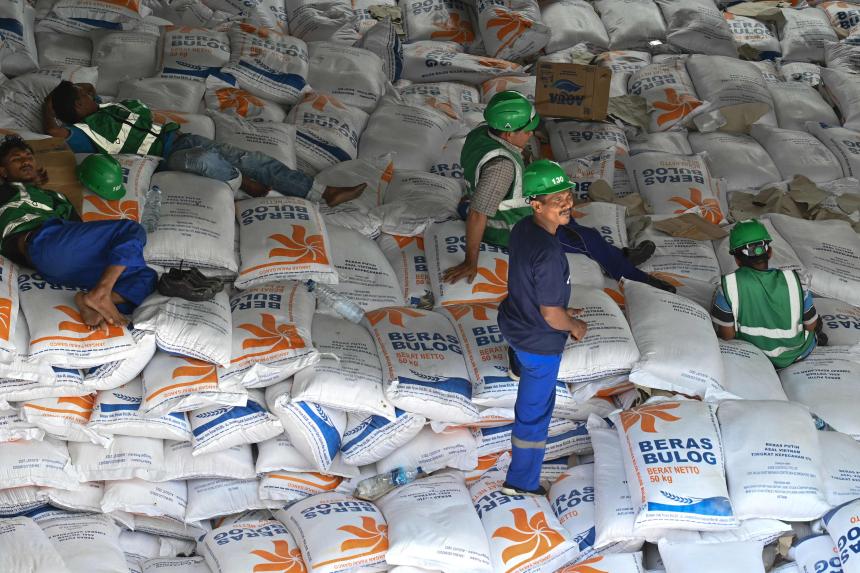JAKARTA – Indonesia is reeling from the spike in rice prices that hit a record high in October, with food stalls and households forced to serve smaller rice portions on plates and buy lower-quality grain.
The medium-grade rice price on Monday reached a record high of 13,910 rupiah (S$1.20) per kilogram, a spike of 20 per cent from January.
This has forced Jakarta food stall owner Dalmus to reduce by about one-third the portion of rice he puts on his customers’ plates in the last two months.
“It is very hard for me to increase meal prices. My customers will certainly turn away,” the 45-year-old father of two told The Straits Times. “Reducing one-third of the rice portion is not too much or too little. The meal still makes them full.”
Surging food prices will be a key issue that Indonesia’s presidential candidates will address in their campaign ahead of the Feb 14, 2024, election.
More than 100 construction workers, delivery couriers, motorbike taxi drivers and other low-wage labourers flock daily to Mr Dalmus’ two food stalls in West Jakarta, spending between 10,000 and 12,000 rupiah each for rice, egg and vegetables.
Mr Dalmus, who goes by one name, has also replaced medium-grade rice, whose price has climbed from 570,000 rupiah per 50kg sack to 700,000 rupiah – a 23 per cent hike from August – with lower-grade rice sold at 650,000 rupiah.
Still, he said his daily sales have declined by 20 per cent to two million rupiah.
“Some customers buy only cooked dishes. They cook rice on their own,” Mr Dalmus said. “It is very tough. I manage to get only a little profit.”

The surge in rice prices is caused by dry weather due to the El Nino weather phenomenon that has dried up padi fields in the last three months in Indonesia.
Other countries have been affected by dry weather too. India, the world’s biggest exporter of rice, has curbed its exports since July because of rising food prices, high inflation and fear of rice shortage due to El Nino disruptions.
Mr Angga Hermanda, an activist at Indonesia Farmers Union, told ST that some regions with poor irrigation systems, such as parts of Banten province in Java, have been affected by the drier weather, resulting in a decline in rice production.
A number of farmers in Banten and Central Java have shifted to planting corn to cope with less water supply, he said.
“The risks are high for rain-fed padi fields,” Mr Angga added. “Those who can rely on irrigation can still grow as usual.”
Securities firm Bahana Sekuritas wrote in its research note: “The recent development in the rice price is worrying as Indonesia is well past its harvest season, or peak rice production period, just when the economy is likely to see year-end inflationary pressure from the holiday period and upcoming elections.”
The Indonesian government has tried to stem the hikes by releasing its rice stockpiles at lower prices in the traditional markets.
Indonesia – unlike other large rice-growing nations such as India and Vietnam – consumes most of its own output.
Indonesia produced 31.5 million tonnes of rice in 2022, according to Statistics Indonesia. The world’s fourth-most-populous nation of 275 million people consumes some 30 million tonnes of rice annually.
Total production in 2023 is predicted to decrease by about 1.2 million tonnes due to the El Nino phenomenon, according to the Agriculture Ministry.

To cover the shortage, Indonesia is importing two million tonnes of rice from countries such as Vietnam and Thailand, with the latest delivery expected in November.
State-owned logistics agency Bulog, which is tasked with the importation, manages rice reserves and distributes rice to low-income households.
Another Jakarta food stall owner, Ms Tarsih Irdayanti, said she has also cut the rice portion in her budget meals, instead of passing the higher costs to customers.
“I only reduce a little rice from my meals. I can’t take much as many of my customers are students,” the 48-year-old mother of four added.
“Besides, we have a lot of competitors here. It is very difficult to raise the price of a meal.”
To keep her profit margin, Ms Tarsih, who runs the food stall in East Jakarta with her husband, now buys rice directly from a rice wholesale market instead of a regular market. She has also switched to a new egg supplier with lower prices. Her new arrangements save up to 375,000 rupiah a month on rice, and 360,000 rupiah on eggs.

Both Mr Dalmus and Ms Tarsih described the recent rice price hikes as “the steepest and longest in two decades”.
“In my 20 years of doing this business, this is the first time I’ve faced this kind of situation. The rice price increase has never been so high and lasted so long,” said Mr Dalmus.
The price hikes of rice are also affecting low-income workers who are paid monthly wages.
Starting in September, Tangerang-based shoe factory worker Anggie Ero Ratalia Putri turned to lower-quality rice to match her home cooking budget.
She used to spend 14,000 rupiah for a litre of rice, but since its price rose to 17,000 a litre, she has bought rice of a lower quality at the same price.
“I need to keep my daily food budget at 30,000 to 35,000 rupiah,” she said.
The 26-year-old, who is single, allocates one-fifth of her monthly wage of 4.5 million rupiah for her parents in East Java and pays a monthly house rent on top of other expenses, such as fuel.
While Ms Tarsih appreciates the government’s move to import rice in a bid to stabilise domestic prices, she hopes that it will also address key problems in Indonesia’s agricultural sector, such as by using technology to boost production.
Anticipating a poor harvest and rice prices to remain high, President Joko Widodo said on Oct 13 that the government would import another 1.5 million tonnes of rice, on top of the two million tonnes already being imported.
“We need to bring in the rice into the markets so that the price will gradually decline,” he said.


